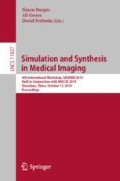Abstract
[\({}^{18}\)F]fluorodeoxyglucose (FDG) positron emission tomography (PET) aids in the localisation of the epileptogenic zone in patients with focal epilepsy, especially when magnetic resonance imaging (MRI) is normal or non-contributory. We propose a two-stage deep learning framework to support the clinical evaluation of patients with focal epilepsy by identifying candidate regions of hypometabolism in [18F]FDG PET scans. In the first stage, we train a generative adversarial network (GAN) to learn the mapping between healthy [18F]FDG PET and T1-weighted (T1w) MRI data. In the second stage, we synthesise pseudo-normal PET images from T1w MRI scans of patients with epilepsy to compare to the real PET scans. Comparing the estimated pseudo-PET images to the true PET scans in healthy control data, our GAN produced whole-brain mean absolute errors of \(0.053 \pm 0.015\), outperforming a U-Net (\(0.058 \pm 0.021\)) and a high-resolution dilated convolutional neural network (\(0.060 \pm 0.024\); all images scaled 0–1). In a sample of 20 epilepsy patients, we created Z-statistic images (with thresholding at +2.33) by subtracting the patient’s true PET scans from their estimated pseudo-normal PET images to identify regions of hypometabolism. Excellent sensitivity for lobar location of abnormalities (\(92.9 \pm 13.1\%\)) was observed for the seven cases with MR-visible epileptogenic lesions. For the 13 cases with non-contributory MR, a lower sensitivity of \(74.8 \pm 32.3\%\) was observed. Our method performed better than a statistical parametric mapping analysis. Our results highlight the potential of deep learning-based pseudo-normal [18F]FDG PET synthesis to contribute to the management of epilepsy.
Access this chapter
Tax calculation will be finalised at checkout
Purchases are for personal use only
References
Kreilkamp, B., Das, K., Wieshmann, U., Biswas, S., Marson, A., Keller, S.: Neuroradiological findings in patients with “non-lesional” focal epilepsy revealed by research protocol. Clin. Radiol. 74(1), 78.e1–78.e11 (2019). https://doi.org/10.1016/j.crad.2018.08.013
Widdess-Walsh, P., et al.: Electro-clinical and imaging characteristics of focal cortical dysplasia: correlation with pathological subtypes. Epilepsy Res. 67(1–2), 25–33 (2005). https://doi.org/10.1016/j.eplepsyres.2005.07.013
Tan, Y.L., et al.: Quantitative surface analysis of combined MRI and PET enhances detection of focal cortical dysplasias. NeuroImage 166, 10–18 (2018). https://doi.org/10.1016/j.neuroimage.2017.10.065
Zhu, Y., et al.: Glucose metabolic profile by visual assessment combined with statistical parametric mapping analysis in pediatric patients with epilepsy. J. Nucl. Med. 58(8), 1293–1299 (2017). https://doi.org/10.2967/jnumed.116.187492
Li, R., et al.: Deep learning based imaging data completion for improved brain disease diagnosis. In: Golland, P., Hata, N., Barillot, C., Hornegger, J., Howe, R. (eds.) MICCAI 2014. LNCS, vol. 8675, pp. 305–312. Springer, Cham (2014). https://doi.org/10.1007/978-3-319-10443-0_39
Sikka, A., Peri, S.V., Bathula, D.R.: MRI to FDG-PET: cross-modal synthesis using 3D U-Net for multi-modal Alzheimer’s classification. In: Gooya, A., Goksel, O., Oguz, I., Burgos, N. (eds.) SASHIMI 2018. LNCS, vol. 11037, pp. 80–89. Springer, Cham (2018). https://doi.org/10.1007/978-3-030-00536-8_9
Pan, Y., Liu, M., Lian, C., Zhou, T., Xia, Y., Shen, D.: Synthesizing missing PET from MRI with cycle-consistent generative adversarial networks for Alzheimer’s disease diagnosis. In: Frangi, A.F., Schnabel, J.A., Davatzikos, C., Alberola-López, C., Fichtinger, G. (eds.) MICCAI 2018. LNCS, vol. 11072, pp. 455–463. Springer, Cham (2018). https://doi.org/10.1007/978-3-030-00931-1_52
Isola, P., Zhu, J.Y., Zhou, T., Efros, A.A.: Image-to-image translation with conditional adversarial networks. In: CVPR 2017, pp. 5967–5976. IEEE (2017). https://doi.org/10.1109/CVPR.2017.632
Ronneberger, O., Fischer, P., Brox, T.: U-Net: convolutional networks for biomedical image segmentation. In: Navab, N., Hornegger, J., Wells, W.M., Frangi, A.F. (eds.) MICCAI 2015. LNCS, vol. 9351, pp. 234–241. Springer, Cham (2015). https://doi.org/10.1007/978-3-319-24574-4_28
He, K., Zhang, X., Ren, S., Sun, J.: Deep residual learning for image recognition. In: CVPR 2016, pp. 770–778. IEEE (2016). https://doi.org/10.1109/CVPR.2016.90
Ioffe, S., Szegedy, C.: Batch normalization: accelerating deep network training by reducing internal covariate shift. In: Bach, F., Blei, D. (eds.) ICML 2015, vol. 37, pp. 448–456. PMLR, Lille (2015)
He, K., Zhang, X., Ren, S., Sun, J.: Delving deep into rectifiers: surpassing human-level performance on ImageNet classification. In: ICCV 2015, pp. 1026–1034. IEEE (2015). https://doi.org/10.1109/ICCV.2015.123
Li, W., Wang, G., Fidon, L., Ourselin, S., Cardoso, M.J., Vercauteren, T.: On the compactness, efficiency, and representation of 3D convolutional networks: brain parcellation as a pretext task. In: Niethammer, M., et al. (eds.) IPMI 2017. LNCS, vol. 10265, pp. 348–360. Springer, Cham (2017). https://doi.org/10.1007/978-3-319-59050-9_28
O’Brien, T.J., et al.: Subtraction ictal SPECT co-registered to MRI improves clinical usefulness of SPECT in localizing the surgical seizure focus. Nucl. Med. Commun. 19, 31–45 (1998)
Colliot, O., Antel, S.B., Naessens, V.B., Bernasconi, N., Bernasconi, A.: In vivo profiling of focal cortical dysplasia on high-resolution MRI with computational models. Epilepsia 47(1), 134–142 (2006). https://doi.org/10.1111/j.1528-1167.2006.00379.x
Smith, S.M.: Fast robust automated brain extraction. Hum. Brain Mapp. 17(3), 143–155 (2002). https://doi.org/10.1002/hbm.10062
Modat, M., et al.: Fast free-form deformation using graphics processing units. Comput. Methods Programs Biomed. 98(3), 278–284 (2010). https://doi.org/10.1016/j.cmpb.2009.09.002
Sutskever, I., Martens, J., Dahl, G., Hinton, G.: On the importance of initialization and momentum in deep learning. In: Dasgupta, S., McAllester, D. (eds.) ICML 2013, vol. 28, pp. 1139–1147. PMLR (2013)
Tustison, N.J., et al.: N4ITK: improved N3 bias correction. IEEE Trans. Med. Imaging 29(6), 1310–1320 (2010). https://doi.org/10.1109/TMI.2010.2046908
Spencer, S.S., Theodore, W.H., Berkovic, S.F.: Clinical applications: MRI, SPECT, and PET. Magn. Reson. Imaging 13(8), 1119–1124 (1995). https://doi.org/10.1016/0730-725X(95)02021-K
Kramer, M.A., Cash, S.S.: Epilepsy as a disorder of cortical network organization. Neuroscientist 18(4), 360–372 (2012). https://doi.org/10.1177/1073858411422754
Author information
Authors and Affiliations
Corresponding author
Editor information
Editors and Affiliations
Rights and permissions
Copyright information
© 2019 Springer Nature Switzerland AG
About this paper
Cite this paper
Yaakub, S.N. et al. (2019). Pseudo-normal PET Synthesis with Generative Adversarial Networks for Localising Hypometabolism in Epilepsies. In: Burgos, N., Gooya, A., Svoboda, D. (eds) Simulation and Synthesis in Medical Imaging. SASHIMI 2019. Lecture Notes in Computer Science(), vol 11827. Springer, Cham. https://doi.org/10.1007/978-3-030-32778-1_5
Download citation
DOI: https://doi.org/10.1007/978-3-030-32778-1_5
Published:
Publisher Name: Springer, Cham
Print ISBN: 978-3-030-32777-4
Online ISBN: 978-3-030-32778-1
eBook Packages: Computer ScienceComputer Science (R0)


